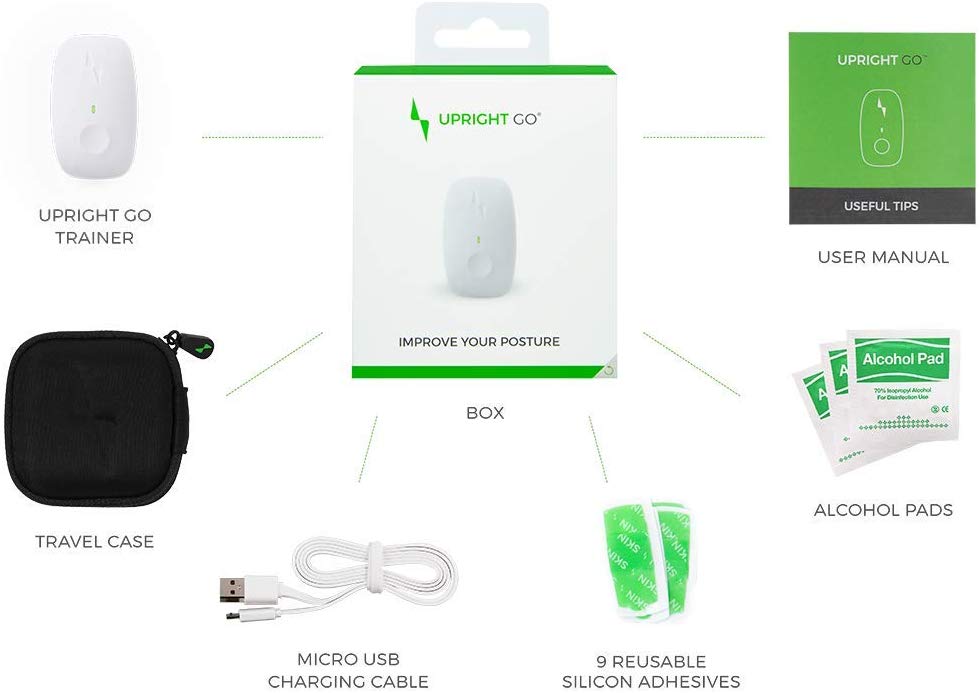Upright Go 2 Review
Summary: Interesting device but questionable data collection
3
Interesting
As a Physiotherapist I am often discussing with my clients the importance of good posture and maintaining correct body biomechanics. In today’s world we are much more sedentary, more flexed/slouched than we once were. I was therefore curious to test out the Upright Go 2 with my client group in mind. I personally don’t suffer from back problems and consider myself to have reasonably good postural alignment. Back pain however is possibly the number 1 reason someone is likely to visit my profession.
The concept of posture correction stems from the idea that the human spine is a series of bony supports that act as a load bearing frame. The more upright we are the less strain on our joints and muscles. Conversely the more we lean away from the vertical the more tension we place on our muscles/tendons and joints. If sustained poor posture is maintained then pain may result. I say, may result, as the body is amazing at adapting and a less than perfect posture for many of us is often not a problem. Causes to back and neck pain are multi-factorial and often unknown. Excessive loading of the tissues has often been accused.
One immediate appeal of the Upright Go 2 is its implicit encouragement of regular use. From an exercise prescription point of view we call this compliance. Compliance to an exercise program is one of the more challenging aspects of helping improve peoples function and pain. Spending $149 straight away ensures a reasonably good chance of compliance.
The Device
A small discreet (approx 4.5cm long) white plastic shell that adheres to your upper back via an adhesive attachment (non-allergenic). There’s a single indented on/off button on the device as well as an LED that shows connectivity and battery life. Also included in the kit is a USB cable and charger as well as multiple reusable stickers and wipes
The Claim
The Upright Go 2 claims to improve your posture within 2 weeks and works on a system of biofeedback that comes in the form of a buzz to your spine when poor posture is detected. There are some other significant benefits claimed by the producers of this device. According to the website, posture equates to mood. Better posture better mood. I can kind of see where this might work – aesthetically one looks better standing tall and therefore there are maybe some self esteem benefits. The claims of a boost to testosterone production and lowering of cortisol levels in the body “making you feel ready to take on any challenge” seems a bit of a reach.
How it works
Setting the device up is simple. It is placed just below your neck and then calibrated to your comfortable, yet correct posture. The Upright Go2 will buzz/vibrate whenever you bend forwards, past this ideal position.
The device offers 2 settings that together aim to improve your posture. The first setting is a training mode – with the goal of maintaining correct posture for a short period. A vibration results whenever “poor” posture is detected. The 2nd setting is a tracking mode that records, over an extended period of time, a history of how long you were upright and how long you slouched. Battery life seemed reasonably good, lasting 2-3 days (30 hours according to the fine print) depending on how often you’re ‘buzzed’. There’s also an App that tracks and records your progress through the day.
Does the device stack up?
I wore the device on and off over a month or so, and felt my posture tested on multiple occasions. On more than one occasion I left the device in training mode for an extended period (the app recommends a set number of minutes each day) and it was at this time I experienced what I would consider its primary limitation – its inability to accurately determine whether I was maintaining good posture or just simply leaning forwards. Furthermore, my posture could be quite poor, such as slouched, yet reclined in my work chair or home couch and yet I would still be maintaining ‘good’ posture. Good posture, according to this device, is simply considered being vertical. While this may be true in many occasions – everyday life often says otherwise. I found the Upright Go 2 most effective in correcting my posture during running. I actually found this really challenging to maintain. The sticky adhesive doesn’t tolerate sweaty skin either and I nearly lost it on two occasions.
To be honest, I didn’t find the app overly useful – probably because I didn’t feel it accurately represented my posture.
Final Thoughts?
In summary, the Upright Go 2 is a posture tracker that despite several short comings does appear to improve posture. The most significant limitation is its questionable data collection. Despite this users may see results such as improved aesthetics and resulting confidence. Like with other forms of biofeedback, provided one wears the device consistently there is potential in assisting with back/neck pain. Would I recommend it to my clients? Possibly. I think the cost factor would deter some.
Positives
Small discreet device that improves posture
Negatives
Questionable data collection, cost, may fall off during strenuous activity













